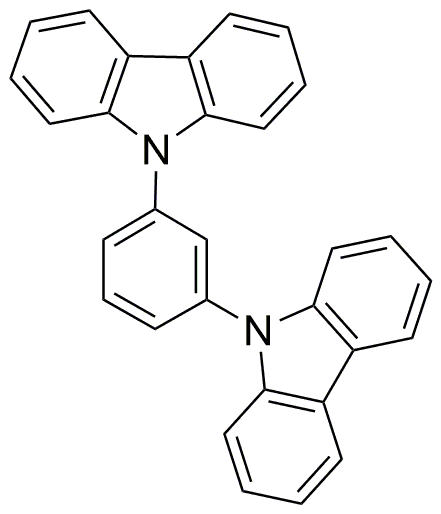1,3-Di-9-carbazolylbenzene is widely utilized in research focused on:
- Organic Light Emitting Diodes (OLEDs): This compound serves as an effective emitter material in OLEDs, enhancing light efficiency and color purity, which is crucial for the display and lighting industries.
- Organic Photovoltaics: It is used in the development of organic solar cells, where its excellent charge transport properties contribute to improved energy conversion efficiency.
- Fluorescent Sensors: The compound is employed in creating fluorescent sensors for detecting environmental pollutants or biological markers, providing a sensitive and selective detection method.
- Polymer Composites: It can be incorporated into polymer matrices to improve mechanical and thermal properties, making it valuable in materials science and engineering applications.
- Pharmaceutical Research: The compound's unique structure allows for exploration in drug development, particularly in targeting specific biological pathways, which can lead to innovative therapeutic agents.
Información general
Propiedades
Seguridad y normativas
Aplicaciones
1,3-Di-9-carbazolylbenzene is widely utilized in research focused on:
- Organic Light Emitting Diodes (OLEDs): This compound serves as an effective emitter material in OLEDs, enhancing light efficiency and color purity, which is crucial for the display and lighting industries.
- Organic Photovoltaics: It is used in the development of organic solar cells, where its excellent charge transport properties contribute to improved energy conversion efficiency.
- Fluorescent Sensors: The compound is employed in creating fluorescent sensors for detecting environmental pollutants or biological markers, providing a sensitive and selective detection method.
- Polymer Composites: It can be incorporated into polymer matrices to improve mechanical and thermal properties, making it valuable in materials science and engineering applications.
- Pharmaceutical Research: The compound's unique structure allows for exploration in drug development, particularly in targeting specific biological pathways, which can lead to innovative therapeutic agents.
Documentos
Hojas de datos de seguridad (HDS)
La SDS proporciona información de seguridad completa sobre la manipulación, el almacenamiento y la eliminación del producto.
Especificación del producto (PS)
La PS proporciona un desglose completo de las propiedades del producto, incluida la composición química, el estado físico, la pureza y los requisitos de almacenamiento. También detalla los rangos de calidad aceptables y las aplicaciones previstas del producto.
Certificados de análisis (COA)
Busque certificados de análisis (COA) ingresando el número de lote del producto. Los números de lote y de partida se pueden encontrar en la etiqueta de un producto después de las palabras "Lote" o "Lote".
Número de catálogo
Número de lote/lote
Certificados de origen (COO)
Este certificado de origen confirma el país en el que se fabricó el producto y también detalla los materiales y componentes utilizados en él y si se deriva de fuentes naturales, sintéticas u otras fuentes específicas. Este certificado puede ser necesario para cumplir con las normativas aduaneras, comerciales y regulatorias.
Número de catálogo
Número de lote/lote
Hojas de datos de seguridad (HDS)
La SDS proporciona información de seguridad completa sobre la manipulación, el almacenamiento y la eliminación del producto.
DownloadEspecificación del producto (PS)
La PS proporciona un desglose completo de las propiedades del producto, incluida la composición química, el estado físico, la pureza y los requisitos de almacenamiento. También detalla los rangos de calidad aceptables y las aplicaciones previstas del producto.
DownloadCertificados de análisis (COA)
Busque certificados de análisis (COA) ingresando el número de lote del producto. Los números de lote y de partida se pueden encontrar en la etiqueta de un producto después de las palabras "Lote" o "Lote".
Número de catálogo
Número de lote/lote
Certificados de origen (COO)
Este certificado de origen confirma el país en el que se fabricó el producto y también detalla los materiales y componentes utilizados en él y si se deriva de fuentes naturales, sintéticas u otras fuentes específicas. Este certificado puede ser necesario para cumplir con las normativas aduaneras, comerciales y regulatorias.


